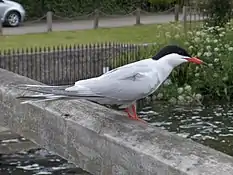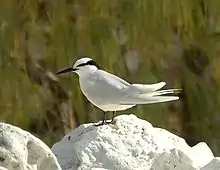| Sterna | |
|---|---|
 | |
| Common tern by the River Thames | |
| Scientific classification | |
| Domain: | Eukaryota |
| Kingdom: | Animalia |
| Phylum: | Chordata |
| Class: | Aves |
| Order: | Charadriiformes |
| Family: | Laridae |
| Tribe: | Sternini |
| Genus: | Sterna Linnaeus, 1758 |
| Type species | |
| Sterna hirundo Linnaeus, 1758 | |
| Species | |
|
13, see text | |
Sterna is a genus of terns in the bird family Laridae. The genus used to encompass most "white" terns indiscriminately, but mtDNA sequence comparisons have recently determined that this arrangement is paraphyletic. It is now restricted to the typical medium-sized white terns occurring near-globally in coastal regions.[1]
Taxonomy
The genus Sterna was introduced in 1758 by the Swedish naturalist Carl Linnaeus in the tenth edition of his Systema Naturae.[2] The type species is the common tern (Sterna hirundo).[3] Sterna is derived from Old English "stearn" which appears in the poem The Seafarer; a similar word was used to refer to terns by the Frisians.[4]
Species
The genus contains 13 species.[5]
| Image | Common Name | Scientific name | Distribution |
|---|---|---|---|
_RWD1.jpg.webp) | Forster's tern | Sterna forsteri | North America. |
 | Snowy-crowned tern or Trudeau's tern | Sterna trudeaui | Argentina, south-east Brazil, Chile, Paraguay and Uruguay |
 | Common tern | Sterna hirundo | Europe, North Africa, Asia east to western Siberia and Kazakhstan, and North America. |
.jpg.webp) | Roseate tern | Sterna dougallii | Atlantic coasts of Europe and North America, and winters south to the Caribbean and west Africa. |
.jpg.webp) | White-fronted tern | Sterna striata | New Zealand and Australia |
 | Black-naped tern | Sterna sumatrana | tropical and subtropical areas of the Pacific and Indian Oceans. |
 | South American tern | Sterna hirundinacea | southern South America, including the Falkland Islands, ranging north to Peru (Pacific coast) and Brazil (Atlantic coast). |
.jpg.webp) | Antarctic tern | Sterna vittata | Uruguay, Argentina, Brazil, Chile, the Falkland Islands, the Heard Island, the McDonald Islands, Australia, and New Zealand. |
 | Kerguelen tern | Sterna virgata | Kerguelen Islands, the Prince Edward Islands (i.e. Prince Edward and Marion) and Crozet Islands. |
.jpg.webp) | Arctic tern | Sterna paradisaea | the Arctic and sub-Arctic regions of Europe, Asia, and North America (as far south as Brittany and Massachusetts). |
 | River tern | Sterna aurantia | inland rivers from Iran east into the Indian Subcontinent and further to Myanmar to Thailand |
.jpg.webp) | Black-bellied tern | Sterna acuticauda | Pakistan, Nepal, India and Bangladesh, with a separate range in Myanmar. |
 | White-cheeked tern | Sterna repressa | coasts on the Red Sea, around the Horn of Africa to Kenya, in the Persian Gulf and along the Iranian coast to Pakistan and western India. |
For the "brown-backed terns" see genus Onychoprion.
References
- ↑ Bridge, E. S.; Jones, A. W. & Baker, A. J. (2005). A phylogenetic framework for the terns (Sternini) inferred from mtDNA sequences: implications for taxonomy and plumage evolution Archived 2006-07-20 at the Wayback Machine. Molecular Phylogenetics and Evolution 35: 459–469.
- ↑ Linnaeus, Carl (1758). Systema Naturae per regna tria naturae, secundum classes, ordines, genera, species, cum characteribus, differentiis, synonymis, locis (in Latin). Vol. 1 (10th ed.). Holmiae (Stockholm): Laurentii Salvii. p. 137.
- ↑ Peters, James Lee, ed. (1934). Check-List of Birds of the World. Vol. 2. Cambridge, Massachusetts: Harvard University Press. p. 331.
- ↑ "Sterna". Oxford English Dictionary (Online ed.). Oxford University Press. (Subscription or participating institution membership required.)
- ↑ Gill, Frank; Donsker, David; Rasmussen, Pamela, eds. (July 2021). "Noddies, gulls, terns, skimmers, skuas, auks". IOC World Bird List Version 11.2. International Ornithologists' Union. Retrieved 16 August 2021.
External links
_svg-element.svg.png.webp)

